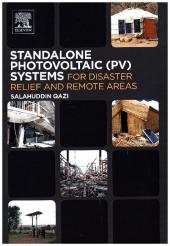 Neuerscheinungen 2016Stand: 2020-02-01 |
Schnellsuche
ISBN/Stichwort/Autor
|
Herderstraße 10
10625 Berlin
Tel.: 030 315 714 16
Fax 030 315 714 14
info@buchspektrum.de |

Salahuddin Qazi
Standalone Photovoltaic (PV) Systems for Disaster Relief and Remote Areas
2016. 308 S. 229 mm
Verlag/Jahr: ELSEVIER 2016
ISBN: 0-12-803022-4 (0128030224)
Neue ISBN: 978-0-12-803022-6 (9780128030226)
Preis und Lieferzeit: Bitte klicken
Standalone Photovoltaic (PV) Systems for Disaster Relief and Remote Areas explores the increased demand for energy, including clean energy alternatives and the ways that solar energy is fast becoming a vital source for meeting peak demand, a solution for energy demand in disaster and remote areas, and a viable source to meet emerging energy security needs.
The book provides a detailed overview of PV systems and applications for disaster and remote areas, and includes a guide on how to provide electricity during outages, along with important discussions on the need for increasing the resilience of the grid. The differences and requirements for standalone, mobile, and portable PV systems are discussed, along with how systems can be deployed, transported, and used in remote areas. In addition, the book discusses the use of solar PV systems to create environmentally friendly power systems for remote communities that can be operated independently, also comparing the costs, emissions, and practical applications of other technologies.
Types of natural disasters, their effect on peoples´ lives, on world economy, impact on electric grid and costs of power outages
Energy Needs in the aftermath of disasters and remote areas both in developed and developing Countries, including how PV systems can provide electricity affordably, with resilience and reducing grid impact by way of community solar and solar microgrid
Detailed description of the types and components of standalone photovoltaic systems, modeling and simulation and performance analysis
New initiatives, programs and case studies for providing solar-generated electricity to low-income people both in the United States and the developing world at low cost
Examples of assembling one´s own PV module and dye-sensitized solar cells, results, databases and industry standards
1. Natural Disasters and Remote areas
2. Photovoltaic System
3. Mobile Photovoltaic Systems for Disasters and Remote Areas
4. Portable Photovoltaic Systems for Disasters and Remote Areas
5. Standalone (fixed) Photovoltaic Systems for Disasters and Remote Areas
6. Resilience and Affordability of Photovoltaic Systems for Disasters and Remote Areas
7. Solar Photovoltaic (PV) Cells
8. Building Your Own Solar PV Modules
Qazi, Salahuddin
Prior to becoming an Emeritus Professor, he spent a year completing a project on developing instructional material for an NSF-funded project on "Visualization and Manipulation of Nanoscale Components using Atomic Force Microscopy. For the last 30 years at SUNYIT, he taught and developed courses in the area of fiber optics, wireless communication, optical communications, nanotechnology, photovoltaic energy, computer and data communication. During his tenure at SUNYIT, he was chairman of the EET department, coordinator of the photonics program and Director of the Master of Science program in advanced technology, which he helped to develop.
Professor Qazi is a recipient of several awards including the William Goddel award for research creativity at SUNYIT and engineering professionalism by Mohawk Valley Engineering Executive Committee. Professor Qazi forged closer relations with the IEEE Mohawk Valley section, is a life member of IEEE and a member of American Society of Engineering Education. He holds a Ph.D. degree in Electrical engineering from Loughborough University, U.K.


